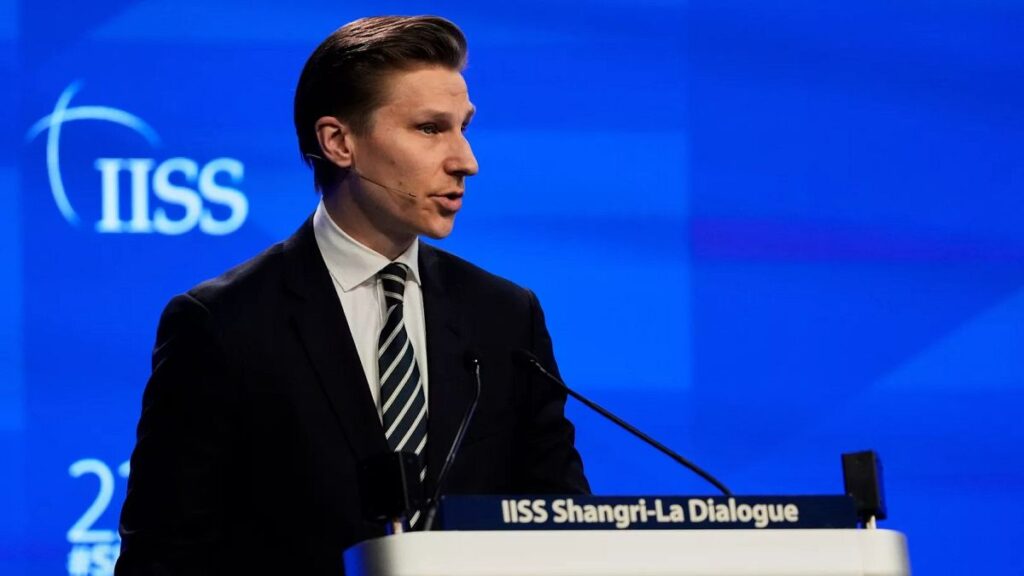Finland’s Defence Minister Antti Häkkänen says Europe is in a race against time to improve its defence capabilities and build its so-called drone wall to counter a growing number of incursions, believed to be from Russia.
“When they [Russia] were running out of missiles they started to produce lots of drones, which is why this has changed the threat picture,” Häkkänen said.
He said Europe faces a number of problems from the wave of recent airspace violations by Russia which saw drones enter countries like Poland and Denmark.
Häkkänen pointed to the huge expense in disabling them and the danger they pose to the population if they’re shot down in civilian areas.
“Everyone has a challenge on how to counter drone threats in a cost effective way without too much collateral damage especially if it’s happening nearby the airport,” he explained.
“It’s hugely challenging to drop a drone in a civil area without collateral damage, using all the force in the military with full spectrum warfare,” he said.
Häkkänen said Russia will always exploit weakness, especially if Europe and the West is “disjointed and unprepared.”
“We know that Russia has always, throughout history, operated aggressively when they see the window of opportunity,” he said.
“If they believe the West is a bit weak and politically a bit messed up, maybe not in good shape in defence, and they think they have an opportunity to take some more land again,” then they will, he pointed out.
“That’s what they thought in 2014 and 2022,” he said.
2014 refers to Russia’s illegal annexation of the Crimean Peninsula, while 2022 is the year Russia launched its full-scale invasion of the country, a war that is ongoing to this day.
“So to avoid that threat Europeans must speed up investments. Real investments. There must be a sense of urgency,” he advised.
What is the drone wall?
Backed by the European Commission, the drone wall aims to combine detection and strike systems that would need to stretch along the borders of at least 10 countries including Finland, Estonia, Latvia, Lithuania and Poland.
“The drone wall is not a wall, but a system of systems,” Sven Kruck, co-CEO of the German drone manufacturer Quantum Systems told Euronews.
“Reconnaissance, sensor fusion and defence, integrated across thousands of kilometres,” Kruck explained adding that “at its core, the project is a network of sensors and defence systems aimed at securing NATO’s eastern flank.”
It’s a centrepiece of Europe’s defence plan for the coming years but there have already been disagreements over how long it would take to be operational.
Evika Siliņa, Latvia’s prime minister, for instance told reporters that she believes a drone wall along the eastern flank could be “doable” within “one year, year and a half.”
This directly contradicts comments made earlier this week at the Warsaw Security Forum by German Defence Minister Boris Pistorius for whom such a project wouldn’t be “realised in the next three to four years.”
Whatever the timeline, both Europe and NATO strongly suspect Russia is behind the recent spate of airspace violations as part of its hybrid war which includes the spread of misinformation and cyberattacks.
Defence spending
Häkkänen says NATO needs to “immediately” start implementing a commitment to spend up to 5% of GDP on defence within as short a timeframe as possible.
All 32 NATO allies agreed to increase defence spending from 2% to 5% of GDP at the NATO summit in The Hague in July, at the urging of US President Donald Trump.
The 5% figure is split with 3.5% going to core defense spending and 1.5% to “defence and security-related spending.”
“We’re hoping the new NATO commitment in spending to 3.5-5% is speeding up fast,” he said.
“The NATO agreement was you have to be fully ready to 3.5% spending in 10 years. No, no, you have to start immediately,” Häkkänen warned.
Häkkänen is defence minister of one of NATO’s newest member countries. In response to the full-scale of invasion of Ukraine, both Finland and Sweden ditched decades of neutrality and jointly submitted applications to join the alliance.
Finland officialy joined in April 2023, with Sweden joining early the next year.
“NATO collective defence has some gaps. Those gaps need to be filled fast,” he said.
The Trump administration has repeatedly told Europe that its defence priorities lie at home and that Washington can no longer be relied upon to guarantee European security.
Washington has also stopped military aid packages to Ukraine, although the US is expected to announce a substantial deal on the purchasing of potentially long-range weapons which will be paid for by Europe.
Nonetheless, it’s a sharp deviation in contrast to the Biden administration when Congress approved over $40 billion in military aid in a single package.
“The US says they are shifting the balance to the Indo Pacific area and their homeland security,” explained Häkkänen.
“And we are seeing the results. The Europeans must pay their fair share and buy the equipment to fill the US gaps,” he told Euronews.
Read the full article here

